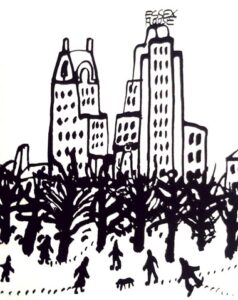🗓️Friday, April 20, 2012
6:30PM-10:00PM
FRANTS GALLERY SPACE
📍81 Wooster St, New York, NY 10012 USA
📧rsvp@frantsgallery.com
Featuring readings by and about Dovlatov by writers:
Lara Vapnyar and Barry Yourgrau.
–The readings will begin at 8:00pm–
ST. PETERSBURG ARTS PROJECT (NY) Invites you to attend the opening reception for “DRAWINGS TO DOVLATOV” by ALEXANDER FLORENSKY
With photography by: Nina Alovert, Leonid Lubianitsky, Mark Sherman, Natasha Sharymova
In collaboration with The Joseph Brodsky Memorial Fellowship Fund
Special thanks to Natasha Sharymova, Elena Dovlatova, Ksana Blank and New York Plus Plus
Writer Sergey Dovlatov (1941-1990) stands out in Russian literature for having placed his works on the border between fierce testimony and playful exaggerations about life. His independent way of thinking was fresh and reviving for many people during the Soviet times and it still is today. In 1979, after being expelled from the Union of Soviet Journalists and conscripted to military service, Dovlatov left Russia and moved to New York where he was free to publish his first two novels Kompromis (”The Compromise”) and Zapovednik (”The Nature Reserve”).
One of his most popular novels, written in the United States, is Inostranka (”A Foreign Woman”), in which Dovlatov vividly portrays the transitional period of a new immigrant who recently left Russia during what was commonly referred to as the Russian emigration of the “third wave.” He knew very well the relations, conflicts and problems of his characters. He indirectly referred to the differences between life in Russia and life in the United States through nuanced descriptions of the day-to-day life. Dovlatov’s vivid portrayal of the need to adapt to a new milieu inspired artist Alexander Florensky to pay homage to Dovlatov’s move to New York and his dedication to a bigger picture of free thought through a series of drawings. These drawings allude to Florensky’s larger role as a member of Mitki, the notorious underground art group in Leningrad, Russia, which rattled the establishment during the years leading up to Perestroika.
The exhibition Drawings to Dovlatov demonstrates Florensky’s and Dovlatov’s similar wit and wisdom and their deep connection to the generation of Russian artists who took on cultural forecasts and were willing to bring on change.
